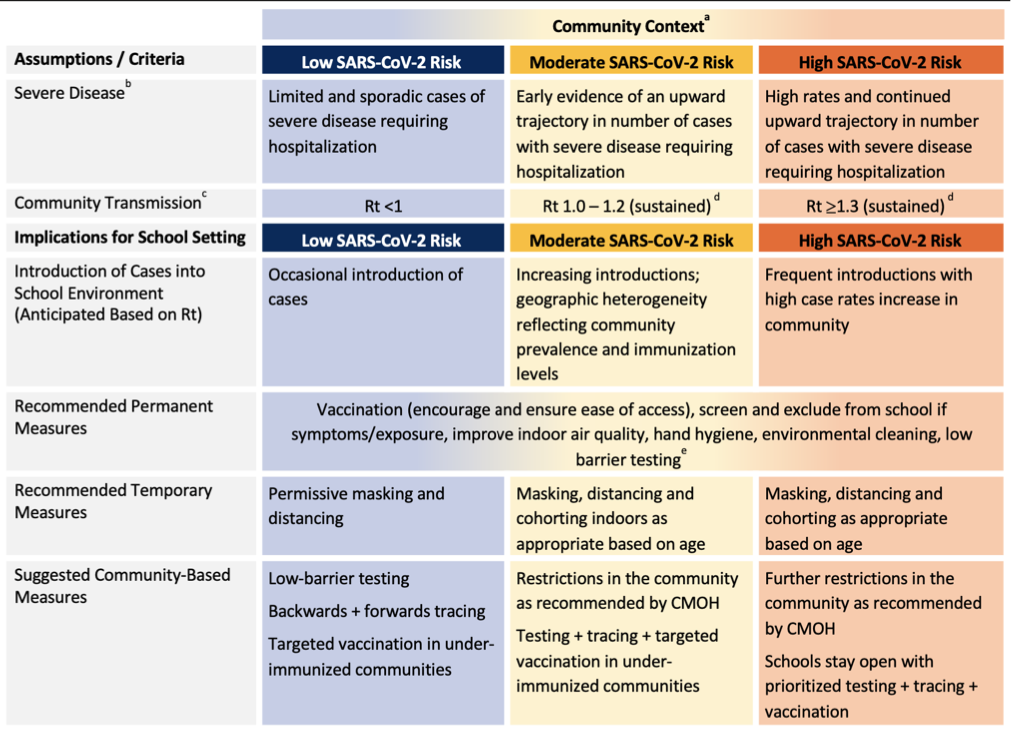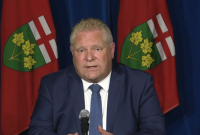Support strong Canadian climate journalism for 2025
Ontario classrooms should be kept open unless "catastrophic circumstances" force them shut after school reopens in September, a group of medical and scientific advisers to the provincial government said Monday.
Extracurricular activities including sports, music and clubs should also be restarted and maintained, the group said, with all school-related activity tied to a sliding scale of protective measures based on the current rate of COVID-19 in the community.
“In-person learning is essential for the learning and overall well-being of children and youth,” the Science Advisory Table wrote in a policy brief. “Therefore, barring catastrophic circumstances, schools should remain open for in-person learning.
“School closures, or transition to an online learning model, should not be used as a public health measure for pandemic control,” it said.
The group, which includes top doctors and other experts from children’s hospitals across the province, said strong uptake of COVID-19 vaccines should mean the spread of severe cases requiring hospitalization is curtailed by September.
Ontario’s schools have been closed since April this year, and its students have spent more time learning from home since the start of the pandemic than those in any other province.
The government has also already told its school boards they must provide an online option throughout the 2021-22 academic year for students and their families who choose not to return to the classroom.
The advisory group considered three broad scenarios from low to high risk in the surrounding community to determine the most appropriate protective measures for schools.
In the low-risk scenario, it recommended contact tracing and low-barrier testing as an early warning system, a permissive approach to masking and no requirement for physical distancing or cohorting, the practice of splitting into smaller groups that have limited contact with other students to help contain any outbreaks.
In the moderate and high-risk scenarios, it suggested cohorting and masking for younger students without the need for physical distancing, and for masking with or without physical distancing and without cohorting for middle and high school students.
It said emphasis should be placed on staying home when sick, indoor air quality, environmental cleaning and hand hygiene.
“It is the combination and consistent application of these layered controls as a bundle that is most effective for reducing disease spread in schools,” it said. “Immunization is the single most effective preventive intervention, and its widespread uptake will dramatically reduce infection rates even among unvaccinated children.”
The advisers said masking, distancing and cohorting rules could be relaxed as vaccination rates increase and fewer people are hospitalized.

In-person learning is the best model for the vast majority of students, it said, since it promotes play, positive peer relationships, physical activity and positive mental health as well as enabling access to a wide range of academic and social-emotional learning opportunities.
It can also help students with their nutrition, security and health needs; connect them to community, mental health and developmental services; and enable parents, especially women and front-line service workers, to work.
Learning loss since the pandemic has been worst in already vulnerable communities and neighbourhoods hardest hit by the virus.
The document did not address youth mental health needs in detail, noting comprehensive guidance is in development.
"Supported by $1.6 billion in investments to protect schools, expand mental health, and support learning recovery, our back-to-school plan will work to ensure a more normal in-class learning experience, including reinstating clubs, sports, and extra-curriculars,” Caitlin Clark, a spokesperson for Education Minister Stephen Lecce, said in an emailed response to the report.
The government is expected to unveil its guidance for schools soon.
The advisers said their recommendations were not intended to serve as exhaustive school guidance, since educators would be best placed to adapt school and class routines to improve health and safety.
The report said most children and youth who get COVID-19 have no symptoms or mild ones such as cough, nasal congestion, runny nose, sore throat, fever, abdominal pain or diarrhea, although severe cases have required intensive care in a small number of cases, particularly among those with certain underlying medical conditions.
But they said it was important to track the long-term impact of COVID-19 on children, noting that in the U.K. one in 10 children aged 2 to 11 and 16 per cent of 12- to 16-year-olds self-reported symptoms persisting three months after acute illness.
It also recommended that school authorities know what portion of staff and eligible students have received one or two doses of vaccine and for public health to have access to individual vaccine status for contact tracing purposes.
While noting that physical distancing can help limit transmission, the report said “social interaction is central to child development and should be encouraged, especially in younger children” and distancing should be recommended or required in low-risk scenarios.
In medium- to high-risk scenarios and for younger children especially, it said cohorting and masking should be prioritized over physical distancing.
In moderate- to high-risk high school scenarios, it said masking and physical distancing are preferred over cohorting, alongside vaccine campaigns where inoculation rates are low.
For extracurriculars, the group suggested choir and orchestra be moved outdoors in smaller, spread-out groups if the weather allows, and to use distancing, masking and low-volume singing if indoors.
For arts and theatre classes, it suggests rehearsing monologues, remote or outdoor performances and small casts that do not require close interaction.
Morgan Sharp / Local Journalism Initiative / Canada’s National Observer







Comments
Throughout the COVID19 pandemic I have questioned the wisdom of closing schools. During the polio epidemic we went to school even though it was several years before we had a vaccine. Were children's immune systems stronger 7 decades ago? I do remember that we did not eat industrial meat, GMOs, homogenized milk or processed foods and, furthermore, nutritionless snacks made of refined sugar and flour were more of a rarity. Perhaps, it's time to investigate what our altered food is doing to our immune system? Could it be that grass fed (from start to finish) organic meats, non-homogenized milk, and organic vegetables and fruit would make us all more resistent to disease?
Possibly. But it wouldn't prevent Covid illness. Why? Because "our immune systems" have not before encountered the virus. That's how it works.
I wonder if the "Science Table" actually reviewed the science on permanent damage to lungs and other organs, even absent major symptoms.
I understand that most parents want their kids looked after off their own premises, but it's as wrong to look to the schools as a babysitting service as it is to have taken the initial approach to simply "save the health care system" as opposed to preventing illness and death amongst the people of Canada.
Recent numbers out of Israel make it clear that vaccinated and unvaccinated alike are at risk when Covid comes into the household, whether or not the first-infected individual self-isolates within the home.
When little kids are getting sick at school, with illnesses whose long-range effects can, literally, ruin their lives, there needs to be something better than, "Oh well, they don't get *very* sick. So, you know, just let'em get sick. No mention about what that does to grandma, who may or may not live with the grandchildren, but who just won't experience the degree of "protection" from full vaccination as younger people do.
That's because their immune systems are susceptible to aging, just like the rest of 'em.
If we've got to a point where children's mental health requires that they be warehoused in institutions for 7-11 hours a day to "maintain resilience," something more is wrong with the system than Covid.